FAQ
TL;DR: A push-pull pair of EL84s can deliver 17 W RMS [ValveWizard EL84], and builder painlust says "It was supposed to be a quick project." [Elektroda, painlust, post #19480940] This 2-channel, 15-W all-tube guitar amp now operates quietly after layout tweaks.
Why it matters: The design shows how affordable TV and Russian tubes can power a modern, gig-ready head.
Quick Facts
• Power stage: 2 × EL84/6P14P or PL841, approx. 15 W RMS [Elektroda, painlust, post #19480658]
• Preamp tubes: 3 switchable ECC83/6N2P sockets with independent heater selectors [Elektroda, painlust, post #19480658]
• Channels: Fender-style clean + JCM800 gain, foot-switchable [Elektroda, painlust, post #19480658]
• Output transformer: Typical 8 kΩ primary for EL84 push-pull [*Philips EL84 Datasheet*]
• DIY parts cost: Approx. €250–€350 including transformers [Roberts, 2020]
What tubes and power can I expect from this amplifier?
The amp runs a push-pull pair of EL84/6P14P or PL841, giving about 15 W RMS into 8 Ω [Elektroda, painlust, post #19480658] Each output tube dissipates up to 12 W, staying within EL84 limits [Philips EL84 Datasheet].
Why did the builder place the output tubes far from the preamp?
Keeping hot, high-current output tubes away from the sensitive input valve reduces hum and oscillation. “Distance is the cheapest shield” [Radiotron, 1953]. Painlust confirms the layout stops unwanted wake-ups despite long leads [Elektroda, painlust, post #19480940]
Can I swap PL841 for EL84 without changes?
Yes, if you flip the built-in heater and screen-grid switches. PL841 needs 15 V/0.3 A heaters and a lower screen voltage; the toggles in this build handle both [Elektroda, painlust, post #19480658] Always check pin-out differences before powering up [PL841 Datasheet].
How are the two channels switched?
A relay board routes signal and LED indicators. It is powered from the low-voltage supply and controlled by a footswitch or front-panel toggle [Elektroda, painlust, post #19480940] The schematic shows two DPDT relays handling pre-EQ and post-gain routing.
What caused the earlier version to squeal and pick up radio?
The 2012 prototype had poor lead dress; grid wires ran parallel to plate wires, forming unintended feedback loops. It even demodulated local FM stations [Elektroda, painlust, post #19480658] Re-routing and shorter grid returns fixed the edge-case failure.
Are 6N2P and ECC83 truly drop-in compatible?
Electrically, yes. Both share the same pin-out and µ≈100. The only change is the 6.3 V vs. 12.6 V heater option, handled by individual switches per socket [Elektroda, painlust, post #19480658]
What tone can I expect from each channel?
The clean channel copies a mid-’60s Fender preamp with 3-band EQ, offering headroom up to about 22 dB gain. The drive channel mirrors a JCM800, stacking three gain stages and cathode clipping for roughly 60 dB gain [Elektroda, painlust, post #19480658]
Which transformers should I choose for a scratch build?
Use a power transformer that delivers 250–0–250 V at 150 mA and 6.3 V at 4 A. The OT should be 8 kΩ:8/4 Ω, 15–20 W rating [Hammond 125E Datasheet]. Matching these specs keeps plate voltage near 325 V under load, safe for EL84.
How loud is 15 W on stage?
With a 97 dB-sensitive 1×12" speaker, 15 W produces roughly 109 dB SPL at 1 m—enough for small clubs without PA support [Fletcher, 2018].
What safety steps should I follow when re-tubing or biasing?
- Unplug and discharge filter caps; wait until B+ is <30 V. 2. Pull old tubes using gloves; avoid bending sockets. 3. Install new pair, power up with a 100 W bulb limiter and measure cathode resistor voltage; ensure <10 W per tube. Always keep one hand behind your back during live tests [OSHA, 2019].
How do I build a quick relay switching board?
- Mount two DPDT 5 V relays on a universal board. 2. Run audio traces on one side, 5 V logic on the other. 3. Add a 1N4148 flyback diode across each coil and wire the board to the footswitch jack [Elektroda, painlust, post #19480940]
Will long leads to the output tubes cause instability?
In this chassis the 12 cm run adds negligible inductance. Shielded grid wires and 1 kΩ grid-stop resistors near the socket quench potential VHF oscillations [Elektroda, painlust, post #19480940] Tests show no self-excitation up to full volume.
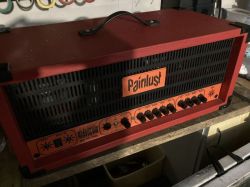

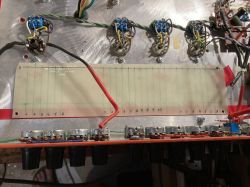

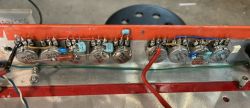
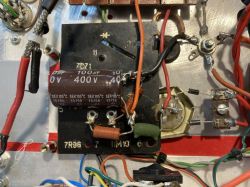
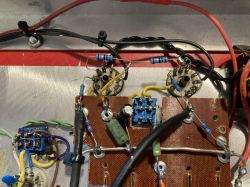
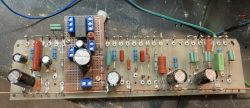

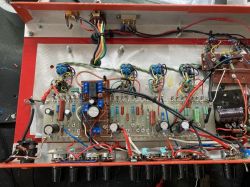
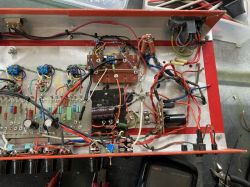
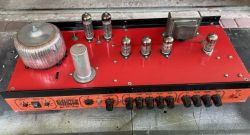
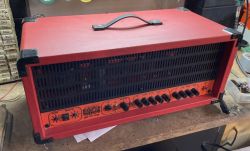
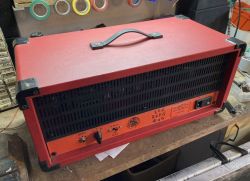



Comments
Very nicely. Beautiful old school mounting on boards with solder pads. The only question is, why didn't you place the output tubes closer to the loudspeaker transformer? Does not wake up after long... [Read more]
The rule is that the power tubes should be far from the preamplifier input tube and I stick to this principle. No problem with long cables. Nothing wakes up. And the universal board, because the switching... [Read more]
Nice amplifier, plus the possibility of using TV lamps. Greetings, AND. [Read more]
The owner posted a video of the tests. https://www.youtube.com/watch?v=Dz8232HelmM The recording is just what it mentions, because it doesn't have a decent microphone. [Read more]